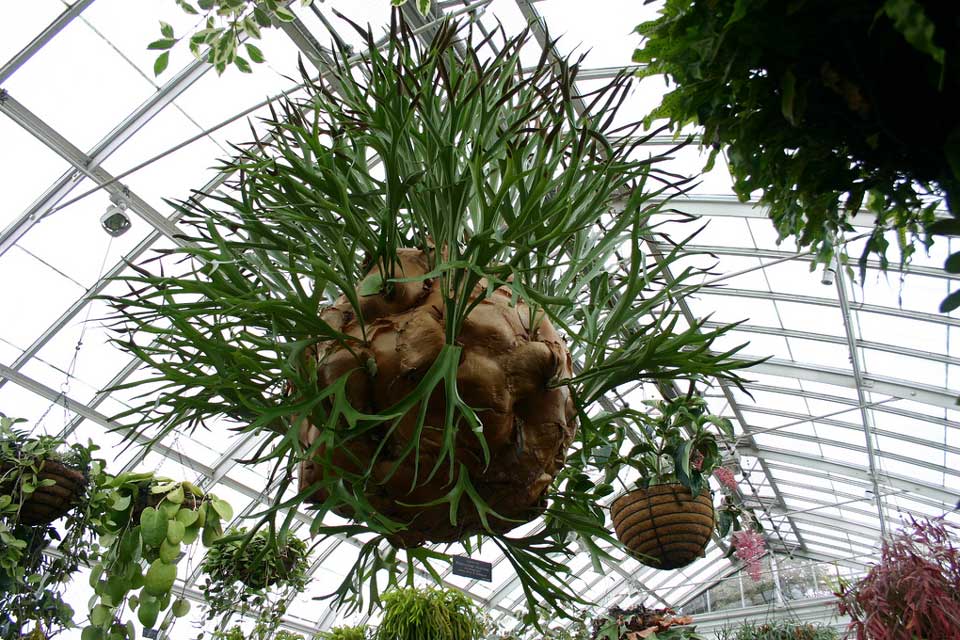
Staghorn ferns, with their striking and unique appearance, have captured the fascination of plant enthusiasts for decades. These epiphytic plants, native to tropical regions, make stunning additions to any greenhouse, creating an enchanting display of cascading fronds and textured antler-like leaves. In this article, we will explore the characteristics of staghorn ferns and provide a comprehensive guide on how to successfully grow and nurture them in a greenhouse setting.
Understanding Staghorn Ferns
Staghorn ferns belong to the Platycerium genus and are renowned for their distinctive growth habit. Unlike most ferns that grow from the ground, staghorn ferns are epiphytic, meaning they naturally attach themselves to trees or other structures. They draw nutrients and moisture from the air and rain, making them well-suited for greenhouse cultivation.
These ferns have two distinct types of fronds: sterile and fertile fronds. Sterile fronds are the shield-shaped, rounded leaves that anchor the plant to its host and collect water and nutrients. Fertile fronds, on the other hand, are the antler-like leaves that extend outward and produce spores for reproduction.
Growing Staghorn Ferns in a Greenhouse
Light and Temperature Requirements
Staghorn ferns thrive in bright, indirect light. Place them in a section of the greenhouse that receives filtered sunlight or dappled shade. Avoid direct exposure to harsh sunlight, as it can scorch the fronds. As for temperature, staghorn ferns prefer a range between 60°F and 80°F, mimicking their native tropical habitats.
Humidity and Ventilation
Staghorn ferns require high humidity levels to flourish. In a greenhouse, maintain humidity by misting the fronds regularly or placing a tray of water near the plants to increase ambient moisture. Adequate ventilation is also crucial to prevent stagnant air and potential fungal issues. Ensure proper airflow within the greenhouse by using fans or opening vents when necessary.
Mounting
Staghorn ferns are typically mounted on a sturdy base, such as a wooden board or basket, to mimic their natural growth habit. Choose a mount that is slightly larger than the fern’s root ball and secure it firmly. You can use sphagnum moss or a suitable mounting medium to secure the roots and retain moisture. Hang the mount in a prominent location in the greenhouse where the fern can grow and cascade freely.
Watering and Fertilizing
Staghorn ferns have unique watering needs. Water them thoroughly, allowing water to run through the moss and roots, and then allow the mount to partially dry out before watering again. Avoid overwatering, as it can lead to root rot. Fertilize staghorn ferns with a diluted, balanced liquid fertilizer once a month during the growing season to provide essential nutrients.
Pruning and Maintenance
Regularly inspect your staghorn fern for dead or dying fronds. Prune them near the base of the plant to maintain its aesthetic appeal and encourage healthy growth. Additionally, keep an eye out for pests like mealybugs or scale insects. If an infestation occurs, treat the affected areas with an appropriate insecticide or by manually removing the pests.
Repotting
Staghorn ferns generally do not require frequent repotting. However, if the plant has outgrown its mount or the root ball becomes crowded, carefully remove it from the mount, trim the roots, and transfer it to a slightly larger mount with fresh moss.
Winter Care
During winter, staghorn ferns may enter a period of dormancy. Reduce watering and fertilizing frequency and provide slightly lower temperatures to simulate their natural seasonal changes. Protect the ferns from cold drafts and ensure they receive adequate but reduced light during this time.
10 Fun Facts About Staghorn Ferns
Unique Growth Habit
Staghorn ferns have a distinctive growth habit. They are epiphytic, meaning they naturally grow on other plants or structures without drawing nutrients from their hosts. Instead, they absorb moisture and nutrients from the air and rain, making them air plants.
Ancient Plant Lineage
Staghorn ferns belong to one of the oldest plant lineages on Earth, dating back over 300 million years. They have survived and adapted through various environmental changes over time, making them living fossils.
Antler-Like Fronds
The fertile fronds of staghorn ferns are called antler fronds due to their resemblance to deer antlers. These fronds extend outward, giving the plant its characteristic antler-like appearance.
Air Purification
Staghorn ferns are excellent air purifiers. They absorb and filter toxins and impurities from the air, improving air quality in their surroundings. This makes them a beneficial addition to indoor spaces.
Edible Leaves
In some cultures, the young, tender leaves of staghorn ferns are consumed as vegetables. They are cooked or eaten raw and are said to have a slightly tangy or citrus-like flavor.
Slow Growth
Staghorn ferns are not known for their rapid growth. They typically grow slowly, adding only a few new fronds each year. This slow growth rate contributes to their longevity and makes them perfect for long-term ornamental displays.
Natural Moisture Indicators
The fertile fronds of staghorn ferns change color depending on the moisture levels in their environment. When adequately watered, the antler fronds appear vibrant green. As they dry out, they may turn brown or become papery in texture.
Nursery for Fern Pups
Staghorn ferns are excellent at producing new plantlets called “pups.” These pups grow from the base of the plant or along the antler fronds. They can be carefully detached and potted to grow into new plants.
Adaptability
Staghorn ferns are adaptable plants and can tolerate a wide range of light conditions. While they prefer bright, indirect light, they can also thrive in lower light environments. This adaptability makes them versatile for various indoor and outdoor settings.
Orchid Companions
Staghorn ferns and orchids often make great companions in gardens and greenhouses. Both plants have similar epiphytic growth habits and can be mounted together, creating a visually stunning and harmonious display.
Related Articles & Free Email Newsletter Sign Up
How to Accessorize your Home and Glass Room
How to Decide Which Bench is Best for Your Greenhouse




Comment here